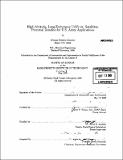| dc.contributor.advisor | John E. Keesee and Brent D. Appleby. | en_US |
| dc.contributor.author | Symolon, William Everette, Major | en_US |
| dc.contributor.other | Massachusetts Institute of Technology. Dept. of Aeronautics and Astronautics. | en_US |
| dc.date.accessioned | 2010-04-28T17:10:38Z | |
| dc.date.available | 2010-04-28T17:10:38Z | |
| dc.date.copyright | 2009 | en_US |
| dc.date.issued | 2009 | en_US |
| dc.identifier.uri | http://hdl.handle.net/1721.1/54620 | |
| dc.description | Thesis (S.M.)--Massachusetts Institute of Technology, Dept. of Aeronautics and Astronautics, 2009. | en_US |
| dc.description | Cataloged from PDF version of thesis. | en_US |
| dc.description | Includes bibliographical references (p. 145-159). | en_US |
| dc.description.abstract | Satellites have become a critical component of nearly every aspect of modern life. In addition to well-known civilian applications, military applications of space-based platforms include supporting mission operations through communications; intelligence, surveillance and reconnaissance (ISR); and position, navigation and timing (PN&T). While satellite applications are numerous and increasing technical achievements make satellites more capable, they do have several drawbacks. Satellites are expensive, they require long development times and they are difficult to replace. Since the successful Chinese anti-satellite (ASAT) missile test on January 11, 2006, U.S. military leaders have become increasingly concerned over this new vulnerability to critical space assets. In addition to efforts designed to improve operationally responsive space capabilities, military leaders have begun researching alternatives to space-based platforms. In November, 2006, the U.S. Army released the Army Space Master Plan (ASMP). In the unclassified extract of that plan, the Army identifies a list of eight topics for further investigation including the question, "Where should the Army invest in near-space and high-altitude, long-endurance [HALE] platforms as a lower cost, more responsive alternative to space platforms if they prove technically feasible?" This thesis discusses technical challenges associated with making HALE platforms feasible and explores the potential benefits of using these platforms to augment or enhance the three primary military applications of communications, ISR and PN&T including a detailed examination of current satellite-based military payload capabilities and limitations. | en_US |
| dc.description.abstract | (cont.) Finally, this thesis discusses potential methods to integrate HALE capabilities into the current U.S. Army Space Operations doctrine and provides some suggestions for the potential role of Army Space Operations in the design, development, implementation and use of HALE systems. By demonstrating how the Army can use HALE platforms to reduce the capability gap and fulfill more of the users' requirements, this research will answer the question posed in the Army Space Master Plan. | en_US |
| dc.description.statementofresponsibility | by William Everette Symolon. | en_US |
| dc.format.extent | 159 p. | en_US |
| dc.language.iso | eng | en_US |
| dc.publisher | Massachusetts Institute of Technology | en_US |
| dc.rights | M.I.T. theses are protected by
copyright. They may be viewed from this source for any purpose, but
reproduction or distribution in any format is prohibited without written
permission. See provided URL for inquiries about permission. | en_US |
| dc.rights.uri | http://dspace.mit.edu/handle/1721.1/7582 | en_US |
| dc.subject | Aeronautics and Astronautics. | en_US |
| dc.title | High-altitude, long-endurance UAVs vs. satellites : potential benefits for U.S. Army applications | en_US |
| dc.title.alternative | High-altitude, long-endurance unmanned aerial vehicles vs. satellites | en_US |
| dc.type | Thesis | en_US |
| dc.description.degree | S.M. | en_US |
| dc.contributor.department | Massachusetts Institute of Technology. Department of Aeronautics and Astronautics | |
| dc.identifier.oclc | 601662053 | en_US |
